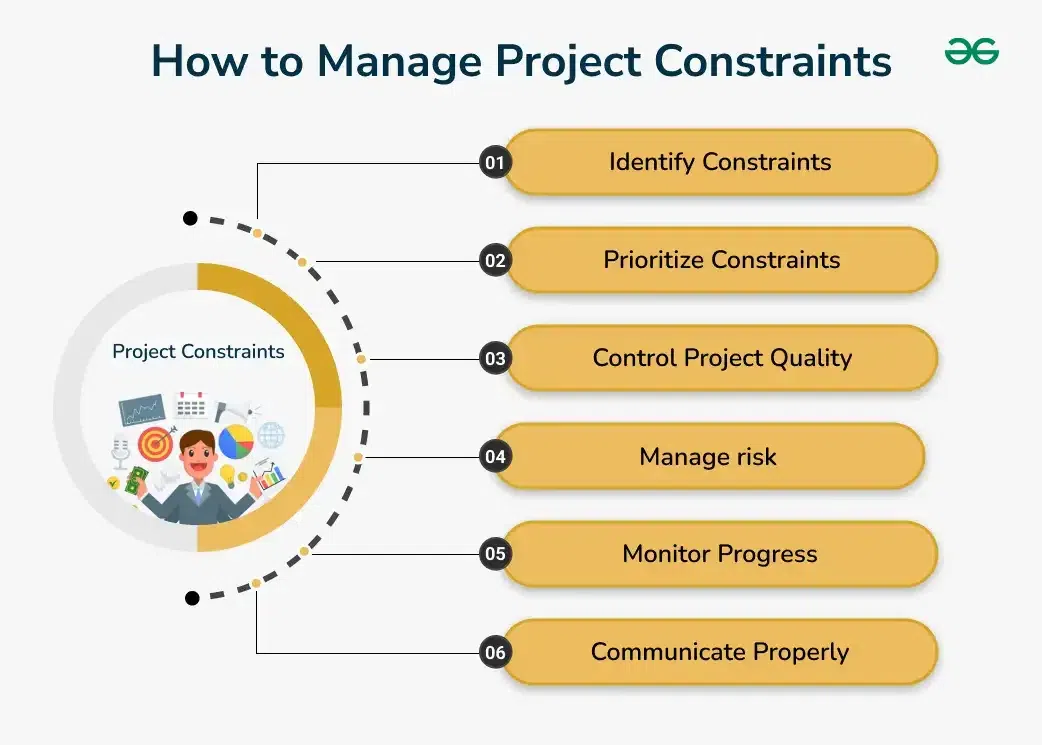
|
|
Constraints in project management are limits or boundaries that have an impact on how a project is carried out. To achieve successful delivery, project managers must take these constraints into account and negotiate them throughout the project lifecycle. Time, money, and scopeal so known as the iron triangle or the triple constraint are the three main limitations in project management. The particular dates and benchmarks that must be reached within the project schedule are referred to as time limitations. Budgetary restrictions pertain to the project’s allotted funds, which cover charges for labour, supplies, and overhead. The project’s scope limits specify what is included and what is not, as well as the precise deliverables and needs. Table of Content What are the Constraints in Project Management?In project management, constraints refer to the limitations or boundaries that may impact a project’s completion. These limitations function as essential guidelines for the project’s control, implementation, and planning stages. In project management, time, money, and scope are the three main constraints that are usually acknowledged. These three constraints are frequently represented as the “triple constraint” or the “iron triangle.” The deadlines and benchmarks that specify the project’s timetable and schedule are referred to as time constraints. The financial resources allotted for the project, such as charges for materials, labour, equipment, and overhead, are included in the cost limitations. Scope restrictions define what is included and excluded from the project’s scope of work by outlining the particular deliverables, objectives, and requirements. The Triple Constraints of Project ManagementHere are the following Triple Constraints of Project Management:  Triple Constraints of Project Management Time constraintA time constraint is a restriction on how long a project can take, setting due dates and benchmarks. Projects often have deadlines to meet market needs or corporate goals. Failure to meet deadlines can lead to missed opportunities, increased expenses, or loss of competitive advantage. Effective time management techniques such as meticulous planning, resource allocation, and regular progress evaluation are crucial to ensure projects stay on track. Tools like Gantt charts and critical path analysis can help manage time constraints effectively.
Scope constraintA scope constraint comprises parameters and restrictions on the amount of work for a project, outlining deliverables, objectives, and requirements. Effective scope management is vital to project success, as uncontrolled modifications or expansions beyond the original scope can lead to scope creep, resulting in increased expenses, delays, or conflicts. To prevent scope creep and ensure alignment with project goals, project managers involve stakeholders early to define and document the project scope, establish change control procedures, and continuously monitor scope throughout the project lifecycle.
Cost constraintA cost constraint limits the amount of money allocated to a project, usually through a set budget that must be carefully monitored to ensure expenses stay within authorized spending caps. Cost management involves estimating, budgeting, and regulating expenses to maximize resource usage and produce value within the budgeted amount. To prevent cost overruns and maintain financial sustainability, project managers must precisely estimate expenses, monitor expenditures, identify cost-saving opportunities, and implement cost control mechanisms. Techniques such as earned value management, variance analysis, and cost-benefit analysis are commonly employed to keep costs under control and empower project managers to make informed decisions.
Other Common Project Constraints to ConsiderIn addition to the three project limitations of scope, cost, and time, you could also run into risks, resources, and quality restrictions during the course of the project. RiskProject risks are any unexpected events that might have an impact on your work. There are some positive project risks, but the majority are bad. For instance, a new technology might be become available while your project is underway. This technology could make your project go more quickly, or it could increase market rivalry and lower the worth of your finished product. some risks can be of the following:
ResourcesResources and project cost restrictions are tightly related since these requirements come with a financial cost. Project quality may suffer, costs may rise, and schedules may be delayed in the absence of appropriate resource allocation. Some Resources include:
QualityHow well your project deliverables live up to your initial expectations is the measure of project quality. Since project quality is your project’s final product, every project limitation has an impact on it. Yet, project quality also has its own limitations because there are elements of the project that can be low quality even though they have nothing to do with money, schedule, resources, risk, or scope. Some Quality include:
How to Manage Project Constraints?Managing project constraints involves identifying, prioritizing, and addressing limitations in scope, time, cost, quality, resources, and risks. Here’s a step-by-step approach:  How to Manage Project Constraints
Conclusion: Constraints in Project ManagementIn conclusion, project success providing value to stakeholders depend on the efficient management of project limitations. Project managers can reduce risks and make sure that expectations from stakeholders are met by properly defining the project’s scope, setting priorities for the needs, and creating reasonable timetables and estimates. Effective constraint management also depends on proactive risk management and open communication, which empowers teams to foresee obstacles and deal with them as they appear. Furthermore, organized methods for managing changes and reducing interruptions to project limits are offered by formal change control procedures. Project managers can fulfill stakeholder expectations, optimize project outcomes, and ensure effective project delivery by utilizing. Constraints in Project Management – FAQsWhat are project constraints?
What makes project restrictions crucial?
How do you determine the limitations of a project?
How do project limitations relate to one another?
|
Reffered: https://www.geeksforgeeks.org
| Project Management |
Type: | Geek |
Category: | Coding |
Sub Category: | Tutorial |
Uploaded by: | Admin |
Views: | 15 |